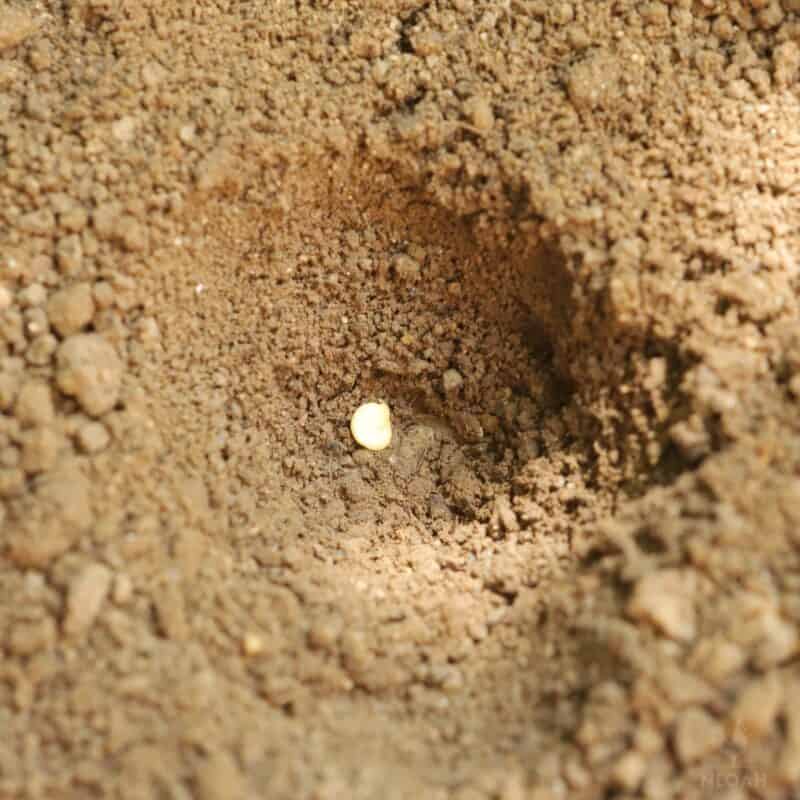No matter what your preferences are when it comes to heat, there’s bound to be a pepper variety for you. From the crisp, green sweetness of bell peppers to the ferocious wallop of the classic cayenne, there is something for every taste.

The good news is that most pepper varieties are basically the same, and have the same growing requirements. So, whatever kind of peppers you want to grow how many seeds should you put per hole?
Plant one pepper seed per hole if you are using new, fresh seeds, and plant two to three per hole if using older or questionable seeds. Underperforming seedlings can be eliminated to make room for the winners after germination.
Peppers have a reputation for being somewhat fussy in regards to conditions, and though I think this is an unfair assertion, there’s definitely a green truth when it comes to the temperature requirements of these plants.
But, assuming you time the planting right it really isn’t too hard. I’ll tell you everything you need to know about growing peppers from seed in this article.
How Deep Should You Plant Pepper Seeds?
Pepper seeds should be planted anywhere from a half inch to ¾ of an inch deep (1.3 to 2 centimeters).
How Wide Should the Hole for Pepper Seeds Be?
The hole for your pepper seeds only needs to be about 1 inch (5 centimeters) wide. Make sure to loosely cover the seed with soil once it is planted, but don’t pack it.
What Special Preparations Should You Make When Planting Pepper Seeds?
Pepper plants take quite a while to mature, and they are also highly sensitive to cold temperatures, requiring sustained temperatures of 75 °F (23 °C) both for germination and for growth.
Accordingly, you’ll probably start your peppers in late spring or early summer.
Peppers always need lots of sunlight, preferably 8 hours or a little more, but no less than 6. Loamy soil that drains well and quickly and has a balanced pH is best.
If you have previously grown peppers, avoid planting them in the same spot since many soil-borne diseases can persist from year to year, and peppers are extremely vulnerable to them.
Until you can properly remediate such soils, rotate your pepper planting site.
Peppers are also known to be nutrient-intensive, and larger pepper varieties and bell peppers in particular need regular applications of fertilizer or compost to supply them with the food they need to grow quickly and grow big.
Avoid giving peppers too much nitrogen early on because they will tend to produce more leaves instead of fruits.
Once the plants germinate and start to grow, make it a point to pinch or prune away the early shoots to promote better and fuller growth.
Don’t be dismayed if they seem to be growing a lot without producing any peppers as they tend to bear fruit rapidly and all at once. Larger varieties will probably require support to keep them from toppling.
How Long Until You Can Harvest Pepper When Planting from Seed?
Depending on the cultivar, your peppers will take at least 2 months to bear edible fruit, and most will take around 10 weeks, possibly 12.
Can You Plant Pepper Seed Indoors?
Yes. Due to their slow overall growth and sensitivity to cold temperatures, many folks decide to start their peppers indoors, or even grow them indoors all the time.
If starting your peppers indoors, do so anywhere from 10 to 12 weeks before the expected last frost of spring.
If you plan on keeping them indoors, make sure you have them near a window that gets lots and lots of sunlight, or else set up grow lamps to supplement their light requirements.
Special Care if Planting Pepper Seeds Indoors
If starting pepper seeds indoors make sure you choose a larger container that can accommodate their deep roots and also the size of the plants once they are mature; some species can grow upwards of 3 feet tall and more resemble a full, leafy bush when bearing fruit!
In all cases, make sure the soil is warm and damp but not soaking wet. Seeds germinate slowly, and require constant warm temperatures to do so.
Consider the use of a container heater or heating mat to achieve the required soil temperature, but keep a close eye on the moisture level since this will dry it out very quickly.
Water regularly, and try to do it directly on the soil and not the plant; peppers are vulnerable to diseases caused by excess moisture, especially when they are young.
If you’re going to move your container peppers outside, or are planning on transplanting them, you must harden them off thoroughly.
Peppers are extremely vulnerable to cold temperatures and can easily be killed by that and a combination of transplant shock.
To prevent this, move your peppers outdoors to a shady spot for about two hours, then bring them inside.
Repeat this process every day for a week and preferably 2, extending the amount of time the peppers are kept outdoors by about 30 minutes.
Once this process is finished, your peppers are ready to stay outside all the time, but again be double-sure temperatures are going to remain well above 55 °F (12 °C), and don’t expect them to thrive until temperatures are consistently at and above 75 °F (24 °C).
Tom has lived and worked on farms and homesteads from the Carolinas to Kentucky and beyond. He is passionate about helping people prepare for tough times by embracing lifestyles of self-sufficiency.
